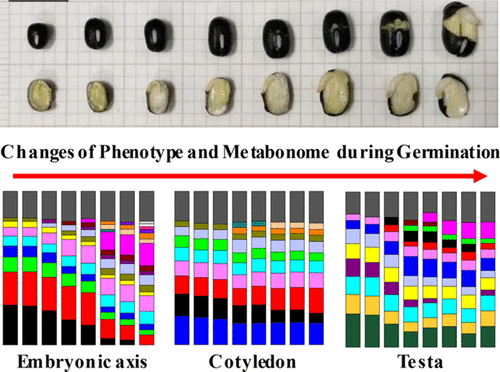当前位置:
X-MOL 学术
›
J. Proteome Res.
›
论文详情
Our official English website, www.x-mol.net, welcomes your
feedback! (Note: you will need to create a separate account there.)
Quantitative Metabonomic Phenotypes in Different Structures of Mung Bean (Vigna radiata) Seeds and Their Germination-Associated Dynamic Changes.
Journal of Proteome Research ( IF 3.8 ) Pub Date : 2020-06-04 , DOI: 10.1021/acs.jproteome.0c00236 Yunlong Wang 1 , Xiangyu Wu 2 , Yanpeng An 1 , Hui Xie 1 , Fuhua Hao 2 , Huiru Tang 1, 2
Journal of Proteome Research ( IF 3.8 ) Pub Date : 2020-06-04 , DOI: 10.1021/acs.jproteome.0c00236 Yunlong Wang 1 , Xiangyu Wu 2 , Yanpeng An 1 , Hui Xie 1 , Fuhua Hao 2 , Huiru Tang 1, 2
Affiliation

|
Plant seed germination involving dynamic water uptakes and biochemical changes is essential for preservation of plant germplasm resource and worldwide food supply. To understand the germination-associated compartmental biochemistry changes, we quantitatively analyzed the metabolite composition (metabonome) for embryonic axes, cotyledons, and testae of mung bean (Vigna radiata) seeds in three germination phases using the NMR-based metabonomics approach. We found that three structures of mung bean seeds had distinct metabonomic phenotypes dominated by 53 metabolites including amino acids, carbohydrates, organic acids, choline metabolites, nucleotides/nucleosides, and shikimate-mediated secondary metabolites together with calcium and magnesium cations. During germination, all three seed structures had outstanding but distinct metabonomic changes. Both embryonic axis and cotyledon showed remarkable metabolic changes related to degradation of carbohydrates and proteins, metabolism of amino acids, nucleotides/nucleosides, and choline together with energy metabolism and shikimate-mediated plant secondary metabolism. The metabonomic changes in these two structures were mostly related to multiple functions for biochemical activities in the former and nutrient mobilizations in the latter. In contrast, testa metabonomic changes mainly reflected the metabolite leakages from the other two structures. Phase 1 of germination was featured with degradation of oligosaccharides and proteins and recycling of stored nucleic acids together with anaerobic metabolisms, whereas phase 2 was dominated by energy metabolism, biosynthesis of osmolytes, and plant secondary metabolites. These provided essential metabolic information for understanding the biochemistry associated with early events of seed germination and possible metabolic functions of different seed structures for plant development.
中文翻译:

绿豆(Vigna radiata)种子不同结构的定量代谢组学表型及其与萌发相关的动态变化。
涉及动态水分吸收和生化变化的植物种子发芽对于保护植物种质资源和全球粮食供应至关重要。为了了解发芽相关的区室生化变化,我们定量分析了绿豆(Vigna radiata)的胚轴,子叶和睾丸的代谢物组成(代谢组学))使用基于NMR的代谢组学方法在三个萌发阶段中注入种子。我们发现绿豆种子的三种结构具有独特的代谢组学表型,主要由53种代谢物组成,包括氨基酸,碳水化合物,有机酸,胆碱代谢物,核苷酸/核苷,sh草酸酯介导的次级代谢物以及钙和镁阳离子。在发芽过程中,所有三个种子结构均具有突出但独特的代谢组学变化。胚轴和子叶均显示出显着的代谢变化,这些变化与碳水化合物和蛋白质的降解,氨基酸,核苷酸/核苷和胆碱的代谢有关,以及能量代谢和sh草酸介导的植物次生代谢。这两个结构的代谢组学变化主要与前者生化活动的多种功能和后者的营养动员有关。相反,睾丸的代谢组学变化主要反映了其他两种结构的代谢物泄漏。萌发的第一阶段的特征是寡糖和蛋白质的降解以及已存储的核酸的循环以及厌氧代谢,而第二阶段则以能量代谢,渗透压生物合成和植物次生代谢产物为主导。这些为理解与种子萌发的早期事件有关的生物化学以及植物发育中不同种子结构可能的代谢功能提供了重要的代谢信息。睾丸的代谢组学变化主要反映了其他两种结构的代谢物泄漏。萌发的第一阶段的特征是寡糖和蛋白质的降解以及已存储的核酸的循环以及厌氧代谢,而第二阶段则以能量代谢,渗透压生物合成和植物次生代谢产物为主导。这些为理解与种子萌发的早期事件有关的生物化学以及植物发育中不同种子结构可能的代谢功能提供了重要的代谢信息。睾丸的代谢组学变化主要反映了其他两种结构的代谢物泄漏。萌芽的第一阶段的特征是寡糖和蛋白质的降解以及所储存的核酸的循环以及厌氧代谢,而第二阶段则以能量代谢,渗透压的生物合成和植物次生代谢产物为主导。这些为理解与种子萌发的早期事件有关的生物化学以及植物发育中不同种子结构可能的代谢功能提供了重要的代谢信息。而阶段2则以能量代谢,渗透压的生物合成和植物次生代谢产物为主。这些为理解与种子萌发的早期事件有关的生物化学以及植物生长过程中不同种子结构可能的代谢功能提供了重要的代谢信息。而阶段2则以能量代谢,渗透压物质的生物合成和植物次生代谢产物为主导。这些为理解与种子萌发的早期事件有关的生物化学以及植物生长过程中不同种子结构可能的代谢功能提供了重要的代谢信息。
更新日期:2020-08-08
中文翻译:

绿豆(Vigna radiata)种子不同结构的定量代谢组学表型及其与萌发相关的动态变化。
涉及动态水分吸收和生化变化的植物种子发芽对于保护植物种质资源和全球粮食供应至关重要。为了了解发芽相关的区室生化变化,我们定量分析了绿豆(Vigna radiata)的胚轴,子叶和睾丸的代谢物组成(代谢组学))使用基于NMR的代谢组学方法在三个萌发阶段中注入种子。我们发现绿豆种子的三种结构具有独特的代谢组学表型,主要由53种代谢物组成,包括氨基酸,碳水化合物,有机酸,胆碱代谢物,核苷酸/核苷,sh草酸酯介导的次级代谢物以及钙和镁阳离子。在发芽过程中,所有三个种子结构均具有突出但独特的代谢组学变化。胚轴和子叶均显示出显着的代谢变化,这些变化与碳水化合物和蛋白质的降解,氨基酸,核苷酸/核苷和胆碱的代谢有关,以及能量代谢和sh草酸介导的植物次生代谢。这两个结构的代谢组学变化主要与前者生化活动的多种功能和后者的营养动员有关。相反,睾丸的代谢组学变化主要反映了其他两种结构的代谢物泄漏。萌发的第一阶段的特征是寡糖和蛋白质的降解以及已存储的核酸的循环以及厌氧代谢,而第二阶段则以能量代谢,渗透压生物合成和植物次生代谢产物为主导。这些为理解与种子萌发的早期事件有关的生物化学以及植物发育中不同种子结构可能的代谢功能提供了重要的代谢信息。睾丸的代谢组学变化主要反映了其他两种结构的代谢物泄漏。萌发的第一阶段的特征是寡糖和蛋白质的降解以及已存储的核酸的循环以及厌氧代谢,而第二阶段则以能量代谢,渗透压生物合成和植物次生代谢产物为主导。这些为理解与种子萌发的早期事件有关的生物化学以及植物发育中不同种子结构可能的代谢功能提供了重要的代谢信息。睾丸的代谢组学变化主要反映了其他两种结构的代谢物泄漏。萌芽的第一阶段的特征是寡糖和蛋白质的降解以及所储存的核酸的循环以及厌氧代谢,而第二阶段则以能量代谢,渗透压的生物合成和植物次生代谢产物为主导。这些为理解与种子萌发的早期事件有关的生物化学以及植物发育中不同种子结构可能的代谢功能提供了重要的代谢信息。而阶段2则以能量代谢,渗透压的生物合成和植物次生代谢产物为主。这些为理解与种子萌发的早期事件有关的生物化学以及植物生长过程中不同种子结构可能的代谢功能提供了重要的代谢信息。而阶段2则以能量代谢,渗透压物质的生物合成和植物次生代谢产物为主导。这些为理解与种子萌发的早期事件有关的生物化学以及植物生长过程中不同种子结构可能的代谢功能提供了重要的代谢信息。











































 京公网安备 11010802027423号
京公网安备 11010802027423号